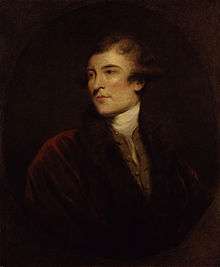Caleb Whitefoord
Caleb Whitefoord FRS FRSE FRSA (1734 – 25 January 1810) was a Scottish merchant, diplomat, and political satirist.
Caleb Whitefoord FRS FRSE | |
|---|---|
 Caleb Whitefoord, by Sir Joshua Reynolds | |
| Born | 1734 Edinburgh, Scotland |
| Died | 25 January 1810 Argyll Street, London, England |
| Nationality | Scottish |
| Citizenship | Great Britain |
| Alma mater | Edinburgh University |
Notable work | Secretary to the commission which concluded peace between Great Britain and the United States at Paris, 1782 |
| Spouse(s) | Mary Sidday |
Life
He was born in Edinburgh in 1734, probably in the family home of Whitefoord House on the Canongate, the illegitimate son of Colonel Charles (James) Whitefoord of the Royal Marines (son of Sir Adam Whitefoord, 1st Baronet),[1] he was educated at James Mundell's School and Edinburgh University.[2]
He moved to London, and in 1756 became a wine merchant.[2]
In 1782, he served as Lord Shelburne's envoy to Benjamin Franklin on the Peace Commission at Paris.[2] On 30 November 1782, during a meeting with Franklin and a French delegate, Whitefoord recorded that the Frenchman "talked of the growing greatness of America; & that the thirteen United States would form the greatest Empire in the World. — Yes sir, I replied & they will all speak English, every one of 'em. His Triumph was check'd, he understood what was intended to be convey'd, viz. that from a similarity of Language Manners and Religion that great Empire would be English not French".[3][4]
In 1784, he was elected a Fellow of the Royal Society of London, and in 1788, upon the proposal of Robert Arbuthnot, Sir William Forbes and Alexander Fraser Tytler he was elected a Fellow of the Royal Society of Edinburgh.[2] In 1800, Whitefoord married a Miss Craven, and had issue, amongst whom an eldest son, Rev. Caleb Whitefoord, M.A. (Oxon.), rector of Burford with Whitton, Herefordshire, had five sons.[1] He died at 28 Argyll Street, London, on 25 January 1810, and was interred at St Mary on Paddington Green Churchyard.[2]
Works
- Whitefoord, Caleb (1781). The daily advertiser, in metre. G. Keasly.
- Whitefoord, Caleb (1799). Advice to Editors of Newspapers. ISBN 978-1-140-69119-8.
Co-authored
- Dobson, Austin; Whitefoord, Caleb (1896). A postscript to Dr. Goldsmith's retaliation: being an epitaph on Samuel Johnson, LL.D.
- Whitefoord, Charles; Whitefoord, Caleb (1898). William Albert Samuel Hewins (ed.). The Whitefoord papers: being the correspondence and other manuscripts of Colonel Charles Whitefoord and Caleb Whiteford, from 1739 to 1810. Clarendon Press. pp. 292. – Charles Whitefoord served in Wynyard's (4th Marines), Gooch's, and the 5th Marines in the 1740s.
References
- The Complete Baronetage, vol. IV, 1665–1707, ed. G. E. Cokayne, William Pollard & Co., 1904, pg 401
- Waterston, Charles D; Macmillan Shearer, A (July 2006). Former Fellows of the Royal Society of Edinburgh 1783–2002: Biographical Index (PDF). II. The Royal Society of Edinburgh. ISBN 978-0-902198-84-5. Archived from the original (PDF) on 4 October 2006. Retrieved 22 March 2011.
- Albert Henry Smyth, The Writings of Benjamin Franklin, Volume X: 1789–1790 (New York: Macmillan, 1907), p. 397
- Stanley Weintraub, Iron Tears: America's Battle for Freedom, Britain's Quagmire: 1775–1783 (New York: Free Press, 2005), p. 324.